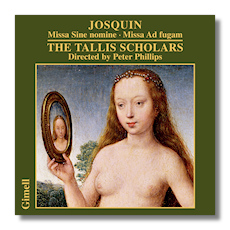
The Internet's Premier Classical Music Source
Related Links
- Josquin Reviews
- Latest Reviews
- More Reviews
-
By Composer
-
Collections
DVD & Blu-ray
Books
Concert Reviews
Articles/Interviews
Software
Audio
Search Amazon
Recommended Links
Site News
 CD Review
CD Review
Josquin des Prés

Early and Late Masses
- Missa Sine nomine
- Missa Ad fugam
The Tallis Scholars/Peter Phillips
Gimell CDGIM039
Josquin des Prés (c.1440-1521) wrote only two masses that were based entirely on canon (the same melody overlaps by beginning in successive parts). They are sumptuously performed on this disk by The Tallis Scholars. It's amazingly beautiful music expertly sung, and can be recommended without reservation to anyone who loves early Renaissance polyphony in particular. And especially to the collector of this remarkable – and prolific – composer's works. The Tallis Scholars' style is the usual polished, gleaming one. Too "perfect", perhaps, for some; yet here not a performance that lacks life or cheer; especially given the mathematically precise nature of the Masses' construction.
True, the second Agnus Dei in Josquin's L'homme armé is but one of several examples of single (mass) movements which Josquin wrote using the distinct form of the canon. Although based as much as anything on a formula, canon is quite able to have a palpable emotional impact: insistence, regularity, clarity, depth and intensity. So it is with these works.
From what we can tell, these two masses occupy places at the beginning and end of Josquin's work.
Missa Ad fugam was probably written early. As much as for any other reason that Josquin may have used canon because such a technique was expected of all Flemish composers, including Ockeghem, from whom the younger composer learned so much. Indeed Peter Phillips, who also wrote the liner notes, speculates that there may have been an extent to which Josquin used the canon in this way and on this occasion not exactly to "outdo" Ockeghem as such, but to show how capable he was in the same area. Indeed! The canon here is invariably between the top and third lines down – so a fifth apart. Since all five movements begin identically, the canon (a tenor on C answering a G three beats earlier) need not vary here. Although later on in the Mass the lag is as much as three bars. As a result of this regularity and pattern, the Missa Ad fugam is much less dense and more transparent than the Missa Sine nomine. There is evidence in the manuscript, now in the library of Jena University in Thuringia (Germany), that someone (it's uncertain whether that was Josquin himself) reworked the canon in the Sanctus and Agnus Dei. So these movements have been included separately by The Tallis Scholars for comparison at the end of the CD [tr.s11,12]
The the Missa Sine nomine was possibly the last (major) work by Josquin before his great Missa Pange Lingua; it demonstrates just what a long way the composer had traveled and how much his skills in the canon form had developed. Phillips also suggests that Josquin consciously chose a canonic form towards the end of his life as a foil to the earlier work with the same feature. The Missa Sine nomine is more complex, yet far from daunting. It's lambent, lovely and limpid. Josquin is not believed to have based either Missa Sine nomine or Missa Ad fugam on existing themes as he did in his "Parody" masses… he composed himself the themes for the works recorded on this disc. The Missa Sine nomine, which is actually shorter than the Missa Ad fugam, follows no such restrictions in the way the canon works. Canon is distributed much more widely and in many more ways throughout the work than in the earlier Mass. It is just as persuasive in a different way.
There is a yet more compelling reason to snap this CD up without hesitating: it contains the only recordings current in the catalogue of these two works. So it's fitting that Phillips (whose is the copyright for this quote) should have such a sane and penetrating comment on the role of canon in (this) music:
I have listened to many pieces of music from all periods with the greatest enjoyment, not knowing that they had canons buried inside them: it is not necessary to follow even the skeleton key to Josquin's mathematics… to find these Masses as engrossing as those which are free. Yet in a sense any successful piece of canonic writing is bound to have an extra dimension to it. The listener will always have the apprehension, however vague, of a presence in the music which complicates and intensifies. It is quite possible that you will never get to the bottom of why a canonic Mass fascinates you, yet it is not necessary to analyze everything to enjoy it. Polyphony is always complex and canonic writing makes the most complex polyphony of all. The best polyphony does not have to be mathematically ingenious, but it should add something if it is.
And it's this sense of the extra which so enhances what's to be heard on this CD – thanks to the singers' superb understanding of these threads as they run through these sublime compositions of Josquin's. Rather than submerging us, the music is consistently misty: not amorphous but fluid. It's not necessary to know that mist is composed of water droplets. Yet Phillips and the Tallis Scholars do know this. And such refinement refreshes anyone who would wash away the dust. Now almost 35 years old, the Tallis Scholars (with eight voices here) have managed to open this music – successfully and unhesitatingly. Buy this wonderful CD!
Copyright © 2008 by Mark Sealey




















